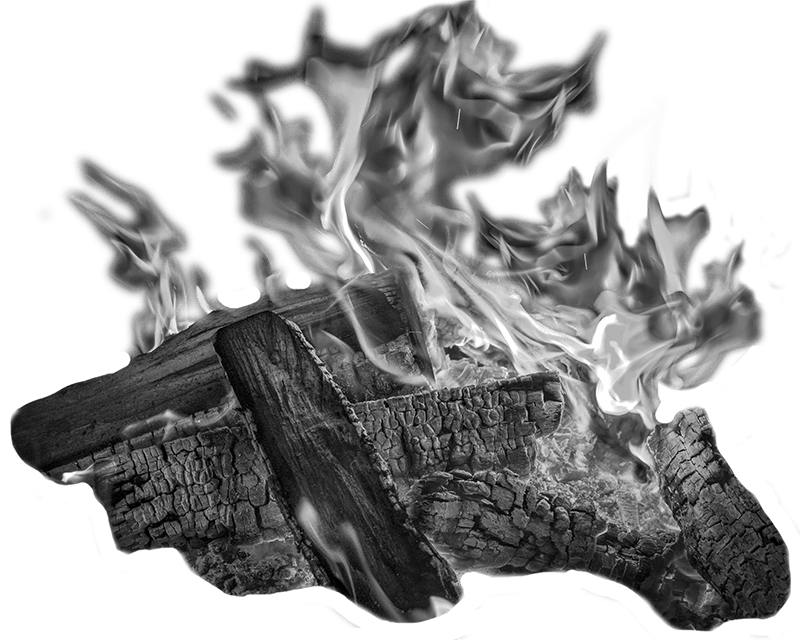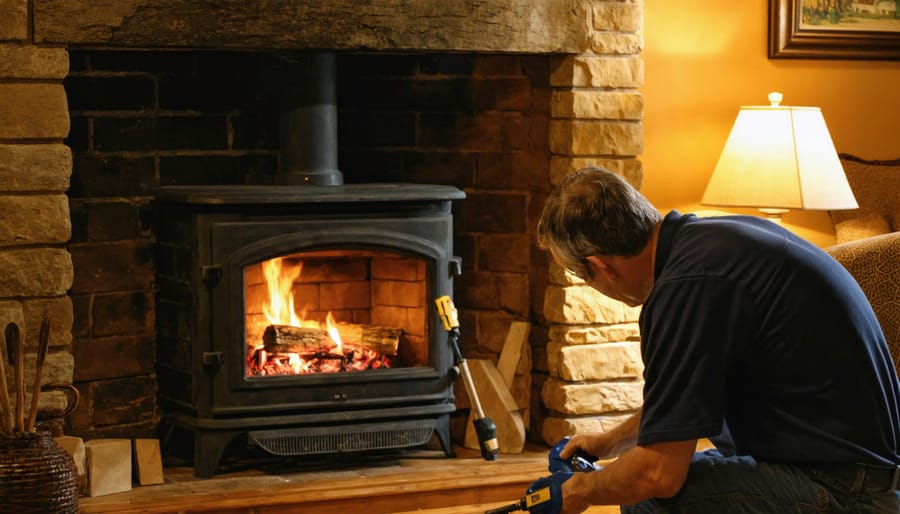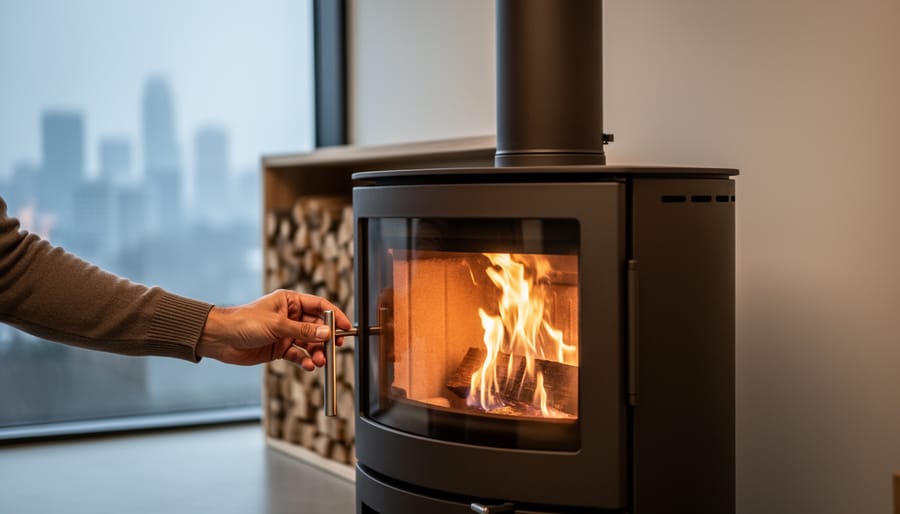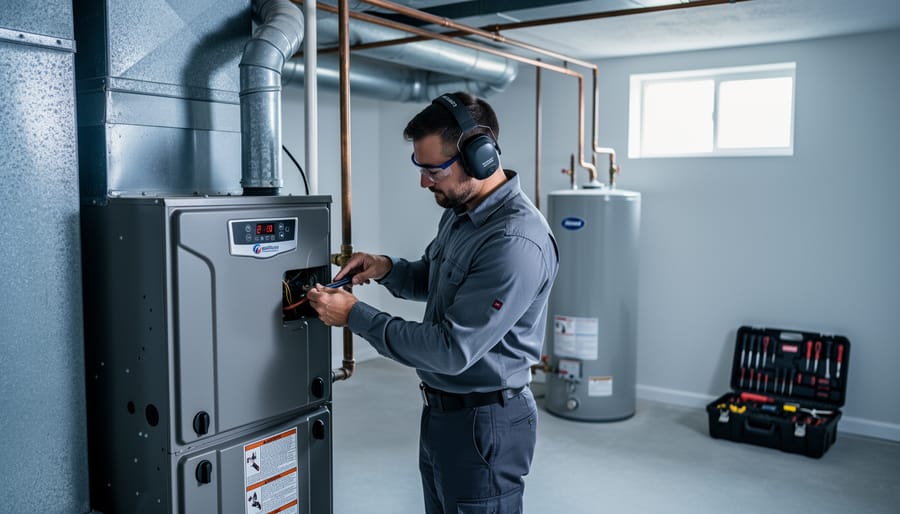Restore your wood burning fireplace insert’s optimal performance with professional-grade diagnostics and targeted repairs. Whether facing deteriorating gaskets, cracked firebricks, or damaged door mechanisms, proper maintenance extends your insert’s lifespan while ensuring safe, efficient home heating. Implementing regular cleaning practices prevents common issues, but when problems arise, swift action protects both your investment and family’s safety. From simple DIY solutions to complex technical repairs, understanding your insert’s repair needs helps maintain its role as your home’s reliable heat source and cherished gathering spot.
Learn to identify warning signs early, tackle basic repairs confidently, and know exactly when to call professionals – ensuring your fireplace insert continues providing the cozy warmth and ambiance you love while maintaining peak efficiency and safety standards. This comprehensive guide walks you through essential repair steps, preventive maintenance, and expert insights for keeping your wood burning insert in pristine condition.
Common Wood Burning Insert Problems and Their Solutions
Door Seal and Gasket Issues
A properly sealed door on your wood burning fireplace insert is crucial for optimal performance and safety. Signs of damaged door seals and gaskets include visible wear, gaps between the door and frame, smoke leakage, or difficulty maintaining consistent temperatures. To check your seals, close the door on a piece of paper – if you can easily pull the paper out, your seal needs attention.
Replacing worn gaskets is a manageable DIY task. Start by removing the old gasket material completely, ensuring the groove is clean of any adhesive residue. Purchase the correct size and type of high-temperature gasket rope from your local fireplace supplier. Apply a thin bead of gasket cement in the groove, then carefully press the new gasket into place. Work slowly around the entire door, avoiding stretching the rope.
For door seals, inspect the flat gasket material for tears or compression. If replacement is needed, remove the old seal, clean the surface thoroughly, and apply the new self-adhesive gasket. Test the door’s seal after installation by performing the paper test again. If you’re unsure about the repair, consult a professional to ensure proper sealing and safe operation.
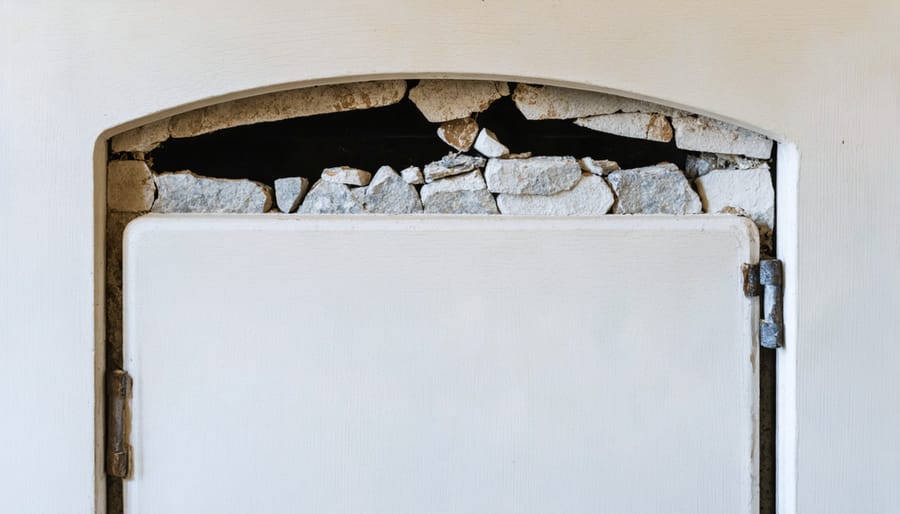
Cracked Firebrick and Interior Damage
Cracked or damaged firebrick in your wood-burning insert isn’t just an aesthetic concern – it’s a serious safety issue that requires prompt attention. These specialized bricks protect your insert’s metal components from extreme heat and prevent heat transfer to surrounding areas. When you notice cracks larger than 1/8 inch or pieces falling away, it’s time to take action.
For minor cracks, you can apply high-temperature refractory cement as a temporary fix. However, severely damaged bricks should always be replaced. To replace damaged firebrick, first ensure the insert is completely cool and remove any ash or debris. Carefully remove the damaged brick using a putty knife or chisel, being cautious not to damage surrounding bricks. Clean the area thoroughly and apply refractory mortar before installing the new firebrick.
Interior components like baffle plates and air tubes may also suffer wear over time. These parts are crucial for proper air flow and efficient burning. When replacing these components, always use manufacturer-approved parts and follow the installation instructions precisely. If you’re unsure about tackling these repairs yourself, consulting a certified fireplace technician is the safest choice.
Blower and Fan Malfunctions
A malfunctioning blower can significantly reduce your fireplace insert’s heating efficiency. Common signs of blower issues include unusual noises, reduced airflow, or complete failure to operate. First, check if the blower is receiving power and that the speed control switch is working properly. Clean or replace the air filter if present, as dust buildup is a frequent cause of poor performance. Listen for grinding or squealing sounds, which often indicate worn bearings that need replacement. Sometimes, the issue might be as simple as loose mounting screws causing vibration. If the motor feels hot or smells burnt, it may need professional replacement. Regular cleaning and lubrication of the blower system can prevent most common problems and extend its lifespan. For safety, always disconnect power before attempting any blower maintenance.
DIY Repair Techniques
Tools and Materials Needed
Before starting any repair work on your wood burning fireplace insert, gather these essential tools and materials to ensure a smooth repair process:
Basic Tools:
– Screwdriver set (flathead and Phillips head)
– Adjustable wrench
– Pliers (regular and needle-nose)
– Wire brush
– Vacuum cleaner with hose attachment
– Flashlight or work light
– Safety glasses and work gloves
– Dust mask or respirator
Cleaning and Maintenance Materials:
– High-temperature silicone sealant
– Fireplace cleaner
– Steel wool or scouring pad
– Clean rags or paper towels
– Gasket material (specific to your insert model)
– Gasket cement or adhesive
Replacement Parts (as needed):
– Door gaskets
– Glass panels
– Door handles or latches
– Firebricks
– Air control mechanisms
Safety Equipment:
– Fire extinguisher (kept nearby)
– Drop cloths or tarps
– First aid kit
Keep these items organized in a dedicated tool box for easy access during maintenance and repairs. Remember to check your insert’s manual for any model-specific tools or materials that might be required for particular repairs.
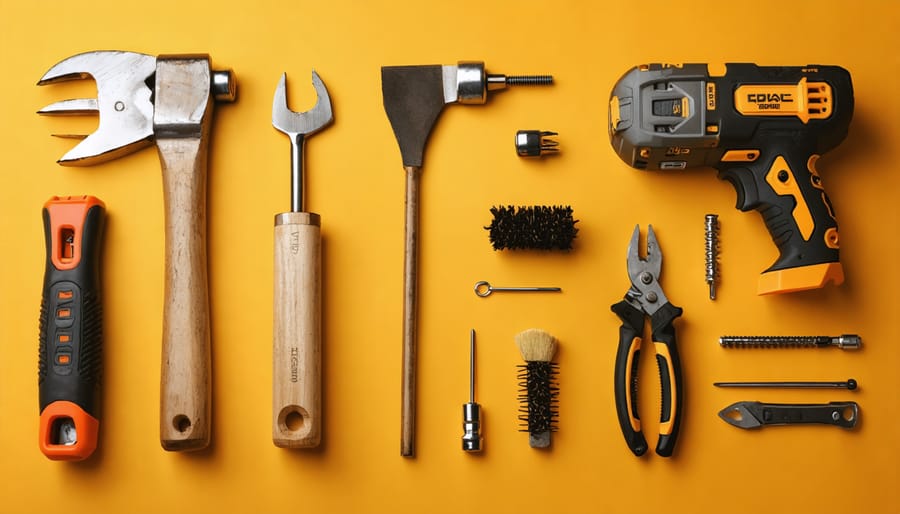
Safety Precautions
Before attempting any repairs on your wood burning fireplace insert, prioritize safety to protect yourself and your home. Always ensure the fireplace is completely cool and hasn’t been used for at least 24 hours. Wear appropriate protective gear, including heat-resistant gloves, safety goggles, and a dust mask to protect against ash and debris.
Clear the area around the fireplace insert of any flammable materials, including rugs, furniture, and decorative items. Keep a fire extinguisher rated for wood fires nearby, and ensure your carbon monoxide detector is working properly. When handling glass doors or metal components, use proper tools to avoid cuts and burns.
Never attempt electrical repairs unless you’re a qualified electrician. If you notice any gas smells (in dual-fuel systems) or unusual odors, stop work immediately and contact a professional. For chimney-related repairs, ensure proper ventilation in your work area and avoid working alone if possible.
Remember to document your repair process with photos before disassembling any components, making reassembly easier and safer. Keep children and pets away from the work area throughout the repair process.
Basic Repair Procedures
When addressing common repair issues with your wood burning fireplace insert, start by inspecting the door gaskets. If you notice air leaks, remove the old gasket carefully and clean the channel with a wire brush. Apply new high-temperature adhesive and install the replacement gasket, pressing firmly for proper adhesion.
For damaged firebricks, carefully remove the broken pieces and clean the area thoroughly. Apply refractory cement to the replacement brick’s edges and position it firmly in place. Allow at least 24 hours for the cement to cure completely before using your insert.
If your insert’s blower isn’t functioning properly, first ensure it’s clean and free from debris. Regular proper ash maintenance can prevent many blower issues. Clean the blower’s housing and fan blades with compressed air and check that all electrical connections are secure.
For door hinges that have become loose or misaligned, tighten all mounting screws and adjust the door position as needed. If the glass is cracked, replace it immediately using only manufacturer-approved replacement panels and high-temperature gasket material.
Remember to check and clean the chimney connector pipes regularly, replacing any sections showing signs of rust or damage. Always use appropriate safety equipment and consult your owner’s manual before attempting any repairs.
When to Call a Professional
Complex Repair Indicators
While many fireplace insert issues can be handled through basic maintenance, certain signs indicate the need for professional expertise. If you notice cracks in the insert’s body or glass door, these could compromise both safety and efficiency. Unusual smoke patterns or persistent backdrafting, even after cleaning, might signal serious draft problems within your chimney system.
A malfunctioning blower that produces grinding noises or operates intermittently requires professional attention, as this could indicate motor failure or electrical issues. Warped or damaged door gaskets that won’t seal properly can lead to dangerous gas leaks and reduced heating efficiency. If you observe significant rust or corrosion on the insert’s surfaces, especially near joints or seams, this may indicate structural deterioration.
Any issues with the catalytic combustor, such as crumbling or visible damage, demand immediate professional assessment. Additionally, if your fireplace insert produces excessive creosote buildup despite regular cleaning, or you notice a strong burning smell when the unit is in operation, these are clear indicators that professional intervention is necessary to ensure your safety and the insert’s proper function.
Choosing a Qualified Technician
When it comes to repairing your wood burning fireplace insert, choosing the right technician is crucial for both safety and performance. Start by verifying that potential technicians are certified by the National Fireplace Institute (NFI) or similar recognized organizations. These certifications ensure they understand current local fireplace regulations and proper installation methods.
Look for technicians with specific experience in wood burning insert repairs, as these units require different expertise than traditional fireplaces. Ask for references and check online reviews from previous customers. A qualified technician should be willing to provide proof of insurance and share examples of similar repair work they’ve completed.
Before hiring, ensure they offer a detailed written estimate and warranty for their work. The best technicians will also perform a thorough inspection before starting repairs and explain their findings in terms you can understand. Don’t hesitate to ask questions about their experience, approach to repairs, and safety protocols – a professional technician will welcome your interest and provide clear, informative answers.
Preventive Maintenance Tips
Regular Maintenance Schedule
To keep your wood burning fireplace insert performing optimally, follow this essential maintenance schedule throughout the year. Monthly tasks include cleaning fireplace ashes, inspecting the door gasket for wear, and checking the glass for any cracks or damage.
Perform these quarterly maintenance tasks: clean the chimney liner, inspect the blower system, and lubricate the blower motor if required. Check all controls and mechanisms for smooth operation, and ensure the firebox is free from excessive creosote buildup.
Semi-annual maintenance should include a thorough cleaning of the entire unit, inspection of the catalytic combustor (if equipped), and examination of all gaskets and seals. Test the door latch mechanism and adjust if necessary. Clean the air intake vents and check for any obstruction in the air wash system.
Annual professional inspection is crucial and should include: comprehensive chimney cleaning, detailed inspection of all components, testing of safety features, and assessment of the overall insert condition. This is also the perfect time to replace worn gaskets, repair any minor damage, and ensure your insert meets current safety standards.
Keep a maintenance log to track these tasks and note any concerning issues that arise. This proactive approach will extend your insert’s lifespan and maintain its efficiency.
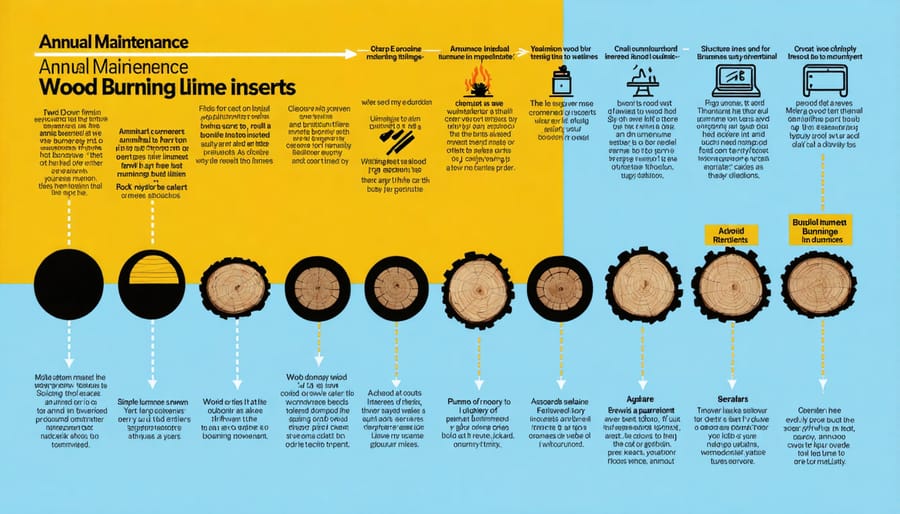
Long-term Care Strategies
To ensure your wood burning fireplace insert serves you well for years to come, implementing proper maintenance strategies is essential. Start with proper fuel selection – using only well-seasoned hardwoods that have been dried for at least six months to minimize creosote buildup and maintain optimal performance.
Establish a regular cleaning schedule, removing ash when it reaches 1-2 inches deep, and thoroughly cleaning the insert at least twice during the burning season. Keep the glass door clean using a specialized fireplace glass cleaner to prevent permanent staining and maintain clear visibility of your fire.
Inspect gaskets annually and replace them when they show signs of wear or compression. These crucial components ensure your insert maintains proper airflow control and efficiency. Consider installing a chimney cap if you haven’t already to prevent moisture and debris from entering your system.
Perform annual maintenance checks before the burning season begins. This includes inspecting the firebox for cracks, checking the door alignment, and ensuring all components are functioning correctly. Have your chimney professionally cleaned and inspected at least once a year to prevent dangerous creosote accumulation and identify potential issues before they become serious problems.
Finally, keep detailed maintenance records and create a calendar reminder system for regular upkeep tasks. This proactive approach will help extend your insert’s lifespan and maintain its heating efficiency for many winters to come.
Maintaining your wood burning fireplace insert is crucial for ensuring your home’s warmth, safety, and energy efficiency. Regular maintenance, coupled with timely repairs, can extend your insert’s lifespan and prevent costly replacements. Remember to conduct seasonal inspections, clean your insert regularly, and address minor issues before they escalate into major problems. Whether you choose to tackle simple repairs yourself or seek professional help, always prioritize safety and proper installation guidelines. By following the maintenance tips and repair solutions discussed, you can enjoy the cozy ambiance of your fireplace insert for years to come while maintaining optimal performance and energy efficiency. Stay proactive in your maintenance routine, and don’t hesitate to contact a certified technician when faced with complex repairs or safety concerns.
